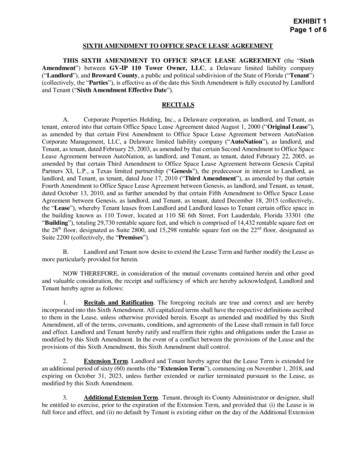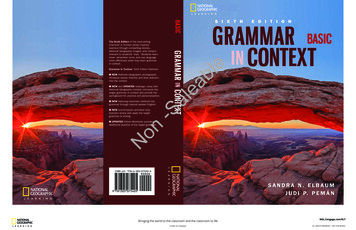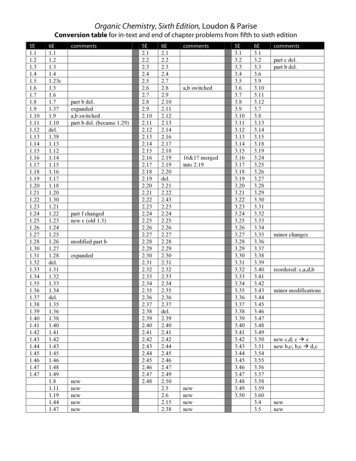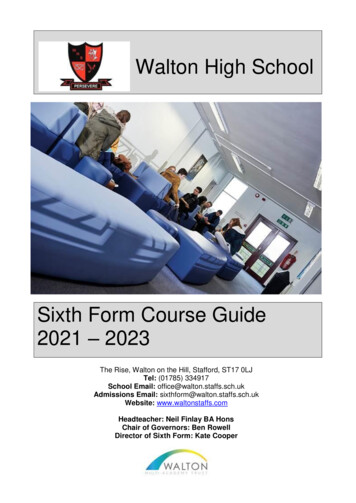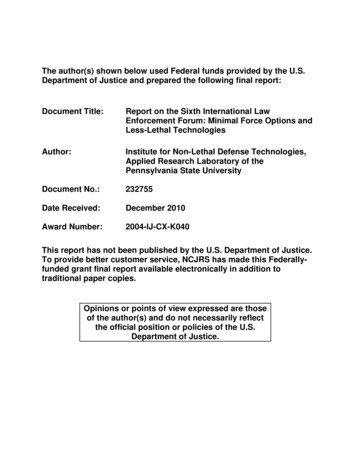
Transcription
The author(s) shown below used Federal funds provided by the U.S.Department of Justice and prepared the following final report:Document Title:Report on the Sixth International LawEnforcement Forum: Minimal Force Options andLess-Lethal TechnologiesAuthor:Institute for Non-Lethal Defense Technologies,Applied Research Laboratory of thePennsylvania State UniversityDocument No.:232755Date Received:December 2010Award Number:2004-IJ-CX-K040This report has not been published by the U.S. Department of Justice.To provide better customer service, NCJRS has made this Federallyfunded grant final report available electronically in addition totraditional paper copies.Opinions or points of view expressed are thoseof the author(s) and do not necessarily reflectthe official position or policies of the U.S.Department of Justice.
This document is a research report submitted to the U.S. Department of Justice. This report has notbeen published by the Department. Opinions or points of view expressed are those of the author(s)and do not necessarily reflect the official position or policies of the U.S. Department of Justice.
This document is a research report submitted to the U.S. Department of Justice. This report has notbeen published by the Department. Opinions or points of view expressed are those of the author(s)and do not necessarily reflect the official position or policies of the U.S. Department of Justice.
This document is a research report submitted to the U.S. Department of Justice. This report has notbeen published by the Department. Opinions or points of view expressed are those of the author(s)and do not necessarily reflect the official position or policies of the U.S. Department of Justice.
This document is a research report submitted to the U.S. Department of Justice. This report has notbeen published by the Department. Opinions or points of view expressed are those of the author(s)and do not necessarily reflect the official position or policies of the U.S. Department of Justice.2008 International Law Enforcement Forum forMINIMAL FORCE OPTIONSReport EditorLieutenant Colonel Edward L. Hughes, U.S. Army-RetiredAcknowledgementsThe delegates of the 2008 International Law Enforcement Forum wish to thankSheriff Kevin Beary and his staff for their gracious hospitality. Additionally, thedelegates wish to thank Mr. John Gnagey and his staff at the National TacticalOfficer Association, in particular Ms. Laura J. Gerhart, for their superb efforts incoordinating the logistics for this event. As always, delegates thank Ms.Amanda Brooks for her continuing administrative support to both theWorkshops and report development.The Sixth International Law Enforcement Forum on Minimal Force Options wasco-hosted by the National Institute of Justice (NIJ), and the Orange CountySheriff’s Office. The forum was organized and conducted by the Institute forNon-Lethal Defense Technologies (INLDT) of The Pennsylvania State Universityand the National Tactical Officer Association (NTOA). The workshop was heldin Orlando, Florida on May 20, 21 & 22, 2008.It remains our view that the pursuit of minimal force options, the policy andlegal aspects of developing and employing such technology, and thesurrounding debates, should be conducted openly and on the basis ofinformed scientific and medical assessment set against clearly articulatedoperational requirements by professionals who have experience in policy,command, operational theaters of use and tactical deployment.The content of this report is not intended to represent any policy and/orofficial position of ILEF, The Pennsylvania State University, the governments ofthe delegates in attendance, or any of their affiliated agencies. Although theconclusions and recommendations are based upon a general consensus of theparticipants, they do not necessarily reflect the views of all of the participantsand/or the agencies which they represent.COMMENTS PERTAINING TO THIS REPORT ARE INVITED AND SHOULD BE FORWARDEDBY POST TO THE DIRECTOR, INSTITUTE FOR NON-LETHAL DEFENSE TECHNOLOGIES,APPLIED RESEARCH LABORATORY, THE PENNSYLVANIA STATE UNIVERSITY, P.O. BOX30, STATE COLLEGE, PA 16804-0030 OR BY ELECTRONIC MAIL TO: INLDT@PSU.EDU.Institute for Non-Lethal Defense TechnologiesApplied Research LaboratoryThe Pennsylvania State University2
This document is a research report submitted to the U.S. Department of Justice. This report has notbeen published by the Department. Opinions or points of view expressed are those of the author(s)and do not necessarily reflect the official position or policies of the U.S. Department of Justice.2008 International Law Enforcement Forum forMINIMAL FORCE OPTIONSPrefaceThe first two meetings of the International Law Enforcement Forum (ILEF) onMinimal Force Options held at The Pennsylvania State University in April 2001and October 2002 were extremely successful in focusing on less-lethalweapons (LLW) and minimal force concepts, technologies and deployment atthe expert practitioner level.The United Kingdom’s Police Scientific Development Branch (now the HomeOffice Scientific Development Branch) hosted the third meeting of ILEF inFebruary 2004 on behalf of the UK government’s steering group on less-lethaltechnologies. The event included a consultative forum with research andevaluation organizations, police oversight bodies, academic and politicalresearch groups, government departments and non-governmentalorganizations (NGOs).The Royal Canadian Mounted Police (RCMP) hosted the fourth meeting of theForum in 2005. This 2005 Forum included a day dedicated to discussion withless-lethal manufacturers and distributors. The 2006 Forum was conducted inFairfax, Virginia and was hosted by the Washington, DC Metropolitan PoliceDepartment who provided an informative tour and information briefing intheir state-of-the-art command center.This year’s Forum in Orlando, Florida brought together persons involved in thedevelopment, use and monitoring of less-lethal technologies and includedrepresentatives from the United Kingdom (UK), the United States (US),Canada, New Zealand, Sweden and Israel. Delegates examined theintegration of less-lethal technologies and use of force in counteringterrorism.Institute for Non-Lethal Defense TechnologiesApplied Research LaboratoryThe Pennsylvania State University3
This document is a research report submitted to the U.S. Department of Justice. This report has notbeen published by the Department. Opinions or points of view expressed are those of the author(s)and do not necessarily reflect the official position or policies of the U.S. Department of Justice.2008 International Law Enforcement Forum forMINIMAL FORCE OPTIONSParticipation in this forum, as in previous years, was by invitation andassembled internationally recognized subject matter experts, chieflypractitioners from law enforcement, together with technical and medicalexperts and those with specific interest in policy development primarily fromthe United Kingdom, Canada, and the United States. As in previous years,delegates from military agencies who are involved with the development anduse of less-lethal technologies also participated. These included the US JointNon-Lethal Weapons Directorate, the Canadian National Defense, and the USDepartment of Homeland Security.This report is a summary of the Forum discussions, the associated conclusions,and recommendations for further work derived from the sessions. The forummakes specific recommendations in relation to best practices in active shooterresponse, critical incidents, acoustic devices, conducted energy devices(CEDs), pursuit management and command/control related to counterterrorism operations.Institute for Non-Lethal Defense TechnologiesApplied Research LaboratoryThe Pennsylvania State University4
This document is a research report submitted to the U.S. Department of Justice. This report has notbeen published by the Department. Opinions or points of view expressed are those of the author(s)and do not necessarily reflect the official position or policies of the U.S. Department of Justice.2008 International Law Enforcement Forum forMINIMAL FORCE OPTIONSTable of ContentsEXECUTIVE kshop PresentationsOpening RemarksMr. Colin Burrows, Chairman, ILEF Advisory Board, UK1414Welcome RemarksSheriff Kevin Beary, Orange County Sheriff’s Office, US (Host Agency)Mr. John Gnagey, Director, National Tactical Officer Association (Co-host)19Keynote AddressDr. John Morgan, Deputy Director, NIJ Office of Science & Technology, US20International Delegate PresentationsCanada – Steve Palmer, Canadian Police Research CentreUnited Kingdom – Graham Smith, Home Office Scientific Development BranchUnited States – Joseph Cecconi, National Institute of JusticeNew Zealand – John Rivers, New Zealand Police23Featured PresentationsColonel Jeff Miller, Commissioner, Pennsylvania State Police, USChief John Timoney, Miami Police Department, USChief Constable Ian Arundale, DyfedPowys Constabulary, UKChief Superintendent Peter Todd, Police Service of Northern Ireland, UKStaff Sergeant Joel Johnston, Vancouver Police, CanadaSergeant Bruce Stuart, Royal Canadian Mounted Police, CanadaStaff Sergeant Chuck McDonald, Royal Canadian Mounted Police, CanadaCharlie Payne, Department of Homeland Security Protective Services, US30Special Military PresentationsColonel Kirk Hymes, Director, Joint Non-Lethal Weapons Program, USSquadron Sergeant Major, Counter-Terrorism Wing, UKMajor Stephan Dufour, Army, Canada40Special Academic PresentationsMatthew Symonds, Home Office Scientific Dev BranchTed Mellors, Penn State Center for Community and Public Safety, USDr. Viktor Bovbjerg, University of Virginia, US45Institute for Non-Lethal Defense TechnologiesApplied Research LaboratoryThe Pennsylvania State University5
This document is a research report submitted to the U.S. Department of Justice. This report has notbeen published by the Department. Opinions or points of view expressed are those of the author(s)and do not necessarily reflect the official position or policies of the U.S. Department of Justice.2008 International Law Enforcement Forum forMINIMAL FORCE OPTIONSWORKSHOP SESSION 1:Active Shooter: Schools and InstitutionsMr. Don Whitson, National Tactical Officer Association, USAssistant Chief Mike Villa, Tukwila Police Department, US55WORKSHOP SESSION 2:Technology Gaps for Critical IncidentsSuperintendent Charles Hill, West Mercia Constabulary, UKInspector Robert Blackburn, London Metro Police, UK61WORKSHOP SESSION 3:Acoustic Devices, Applications and RequirementsDr. Tim Brungart, The Pennsylvania State University, USMr. Mike Hendrickson, The Pennsylvania State University, US63WORKSHOP SESSION 4:Conducted Energy Device (CED) Employment & TechniquesMr. Chris Meyers, Seattle Police Department, USMr. Ed Hughes, The Pennsylvania State University, US67WORKSHOP SESSION 5:Pursuit Management & Vehicle StoppingMr. Don Kester, National Tactical Officer Association, USMr. Mike Hendrickson, The Pennsylvania State University, US69WORKSHOP SESSION 6:Community Impact & Public Order Considerations in CT OperationsStaff Sergeant Joel Johnston, Vancouver Police, CanadaSergeant Marc Lefebvre, Royal Canadian Mounted Police, Canada73WORKSHOP SESSION 7:Critical Incident Command and Control IssuesMr. Trent DePersia, Department of Homeland Security, USMr. Ed Hughes, The Pennsylvania State University, US75WORKSHOP SESSION 8:Urban Crowd Control ConceptsAssistant Chief Joshua Ederheimer, DC Metro Police, USDeputy Chief Thomas Graham, NYPD, USDr. John Kenny, The Pennsylvania State University, US79APPENDICESA – Workshop AgendaB – Focus QuestionsC – AttendeesD – Status of Previous RecommendationsInstitute for Non-Lethal Defense TechnologiesApplied Research LaboratoryThe Pennsylvania State University683859397
This document is a research report submitted to the U.S. Department of Justice. This report has notbeen published by the Department. Opinions or points of view expressed are those of the author(s)and do not necessarily reflect the official position or policies of the U.S. Department of Justice.2008 International Law Enforcement Forum forMINIMAL FORCE OPTIONSExecutive SummaryPolicing involves patrol officers being placed in situations where they arerequired to respond rapidly and appropriately. The circumstances might beconfronting a violent or aggressive individual, maintaining public order, ordealing with terrorists. The officer must observe the potential threat, evaluaterisks to persons and property, consider consequences of any action or inaction,determine the appropriate response, and respond with the appropriate levelof force – often in a matter of seconds. Less-lethal technologies continue toprovide officers with the capability of a variety of force options which reducethe need to resort to lethal force. While generally there are different viewsregarding the role of these devices and related techniques, when operating insuch ambiguous and uncertain situations, there are often many moresimilarities in approach.The 2008 Forum addressed many issues related to best practices inactive shooter response, critical incidents, acoustic devices, conducted energydevices (CEDs), pursuit management and command/control related tocounter-terrorism operations.Delegates from represented countries, disciplines and police departmentsalso examined less-lethal weapons (LLW) and issues in counter-terrorism.There were eight distinct workshop sessions in which the delegatesparticipated: Active Shooter – Schools and Institutions; Technology Gaps for Critical Incidents; Acoustic Devices, Applications and Requirements; Conducted Energy Device (CED) Employment & Techniques; Pursuit Management & Vehicle Stopping; Community Impact & Public Order Considerations in CT Operations; Critical Incident Command and Control Issues; and Urban Crowd Control Concepts.Institute for Non-Lethal Defense TechnologiesApplied Research LaboratoryThe Pennsylvania State University7
This document is a research report submitted to the U.S. Department of Justice. This report has notbeen published by the Department. Opinions or points of view expressed are those of the author(s)and do not necessarily reflect the official position or policies of the U.S. Department of Justice.2008 International Law Enforcement Forum forMINIMAL FORCE OPTIONSThe major recommendations are:1. Less-Lethal Tools in Active Shooter Situations. The ILEF should work withthe NTOA and other organizations to ensure the integration of less-lethalconsiderations into Active Shooter tactical planning. These shouldinclude:9 Officers should incapacitate an active shooter at the earliest possibleopportunity;9 Currently, less-lethal weapons cannot produce predictable andreproducible incapacitating effects, particularly at distance;9 Lethal force remains the most effective means of completelystopping a threat. Officers should not place themselves or other atrisk by substituting less-lethal weapons for lethal weapons in lethalforce confrontations;9 Less-lethal weapons may assist in facilitating a successful resolution.LLWs should be considered complementary tools in a team tacticalresponse kit.2. Active Shooter Response Training. Police departments should evaluatethe concept of training officers to deploy in one and two person contactteams. Police departments should continue to work with schools andinstitutions in preparation for an active shooter scenario.3. LLW Requirement for Active Shooter Situations. Manufacturers andgovernment entities tasked with technology R&D should continue toresearch and develop complementary tools that will assist in the rapidintervention of an active shooter incident. ILEF should forward lesslethal technology requirement to NIJ, HOSDB and CPRC.4. LLW Requirement for Critical Incidents. Manufacturers and governmententities tasked with technology R&D should work to design LLWtechnologies capable of being delivered across greater distances with thecapability for variable periods of incapacitation. ILEF should forward lesslethal technology requirement to NIJ, HOSDB and CPRC.5. Weapon Recognition System. Manufacturers and government entitiestasked with technology R&D should work to design weapon recognitionsystems to enable deployment of LLW technologies. ILEF should forwardthis less-lethal technology requirement to NIJ, HOSDB and CPRC.6. Community Engagement. ILEF should encourage members and affiliatedagencies to promote and exercise community engagement as this buildscommunity confidence and trust in many aspects of policing from use-offorce issues to intelligence gathering.7. LLW Requirement for Acoustic Devices. Acoustic devices must becapable of achieving the desired effect such as delivering intelligible voicecommands and deterrence at the desired range. The device must be safeInstitute for Non-Lethal Defense TechnologiesApplied Research LaboratoryThe Pennsylvania State University8
This document is a research report submitted to the U.S. Department of Justice. This report has notbeen published by the Department. Opinions or points of view expressed are those of the author(s)and do not necessarily reflect the official position or policies of the U.S. Department of Justice.2008 International Law Enforcement Forum forMINIMAL FORCE OPTIONSfor both the operator and target alike and must also be fiscally viable.Some additional requirements are that the device be modular, portableand scalable to accommodate a wide range of constraints (e.g., size,weight, power requirements, etc.). ILEF should forward less-lethaltechnology requirement to NIJ, HOSDB and CPRC.8. CED Standards. ILEF should promote and participate in the developmentof standards for CEDs in terms of performance, test protocols andindependent testing groups to verify these technical standards for LawEnforcement.9. Long-Term CED Effects Study. ILEF should encourage NIJ, HOSDB andCPRC to conduct extended (long term study) research that would identifyand monitor a sample population for indication of any long term effectsfrom CED exposure.10. CED High Risk Population. ILEF should encourage NIJ, HOSDB and CPRCto continue and expand research to determine if any group within thegeneral population is more vulnerable to CED exposure than others.11. CED Research Review. ILEF should encourage NIJ, HOSDB and CPRC toconduct a comprehensive (perhaps cooperative) review of the body ofmedical and engineering research that has been accomplished with a goalof providing the community a report that compiles the results intolayman’s terminology in any easy to understand format.12. Pursuit Policy Guidelines. ILEF should work with NTOA, ACPO and otherassociations on developing and refining recommended pursuit policyguidelines to reflect specific environments and scenarios.13. Pursuit Command and Control. Jurisdictions must be aware of thedanger associated with overloading the officer during a pursuit – toomuch gear and too much information to process equals much higher risk.ILEF should encourage NIJ, HOSDB and CPRC to conduct a cooperativeexamination of best practices regarding command and control for pursuitmanagement in order to develop recommended standard techniques andprocedures that give the pursuing officer a better ability to focus on hispursuit TTPs.14. Cooperative Technologies. That ILEF encourage NIJ, HOSDB and CPRCestablish common objective system requirements and work withmanufacturers to ensure that emerging cooperative technologies:9 Do not damage auto electrical systems;9 Allow police to control the vehicle (stop or slow it down);9 Allow a suspect the ability to bring the vehicle to a controlled stop;9 Provide police with positive identification of the target vehicle; and9 Provide a unit modular capability.Institute for Non-Lethal Defense TechnologiesApplied Research LaboratoryThe Pennsylvania State University9
This document is a research report submitted to the U.S. Department of Justice. This report has notbeen published by the Department. Opinions or points of view expressed are those of the author(s)and do not necessarily reflect the official position or policies of the U.S. Department of Justice.2008 International Law Enforcement Forum forMINIMAL FORCE OPTIONS15. Video (CCTV) Mapping. Police command knowledge of, and ultimatelyaccess to, commercial and security CCTVs in their jurisdiction canmarkedly improve situational awareness for critical incidentmanagement. Imaging/camera systems in particular are important asthey can provide real-time information collection, analysis, and threatassessment that will enable more effective command decisions. ILEFshould encourage DHS, NIJ, HOSDB and CPRC to facilitate video mappingfor local jurisdictions.16. Incident Command SOP. Incident command procedures are morestandardized in the UK than in the US/Canada. ILEF should encourage NIJand CPRC to conduct a cooperative review of best practices and developmore standardized (and perhaps common to or consistent with UK)guidelines for equipment and procedures. These could be proliferated inthe US by tying their adoption to federal funding.Institute for Non-Lethal Defense TechnologiesApplied Research LaboratoryThe Pennsylvania State University10
This document is a research report submitted to the U.S. Department of Justice. This report has notbeen published by the Department. Opinions or points of view expressed are those of the author(s)and do not necessarily reflect the official position or policies of the U.S. Department of Justice.2008 International Law Enforcement Forum forMINIMAL FORCE OPTIONSIntroductionBackgroundIn 1999, the Pennsylvania State University (Penn State) and the Los AngelesSheriff’s Department hosted the International Commission on Policing inNorthern Ireland, chaired by Mr. Chris Patten. It was evident that the issuesassociated with acceptable and effective less-lethal technologies wouldbenefit from a meeting of subject matter experts.The first official meeting of The International Law Enforcement Forum onMinimal Force Options (ILEF), was held at Penn State in April of 2001. Themeeting brought together a small group of US and UK personnel who hadbeen active in researching and developing issues in respect of police use ofless-lethal technologies. Penn State had already been involved with the USmilitary program through its Institute for Non-Lethal Defense Technologies(http://www.nldt.org) and had developed meaningful contacts with US Lawenforcement. The first meeting served to confirm the value of internationalcooperation, which had a law enforcement focus, on the use of less-lethaltechnologies and to work through principles associated with minimal forceoptions and to capture common operational needs.The second ILEF meeting was also held at Penn State. It was conducted inOctober 2002 and identified a number of issues that required some action.The more urgent of these included the development of a less-lethalweapon/technology database, the development of an injury database, thecharacterization of operational needs and the development of standards fordevelopment, testing, and training. Shortly after this second meeting of ILEF,the UK Steering Group chaired by the Northern Ireland Office, in consultationwith the Association of Chief Police Officers, issued its Phase 3 Report(December 2002) on Patten Commission Recommendations 69 and 70,relating to public order equipment. This report included a summary of theILEF meeting and its recommendations. The 4th report of the UK steeringgroup likewise referenced ILEF and its ongoing work to develop internationalstandards for testing and training.The 2004 ILEF meeting (Third ILEF), held in the UK and hosted by theAssociation of Chief Police Officers and the Police Scientific DevelopmentBranch, included policymakers, researchers, and medical experts versed invarious aspects of less-lethal technologies, their applications and their effects.The delegates examined gaps in capabilities and medical assessments,information sharing, and the development of common standards for lesslethal weapons development, testing, training and use. The event included aconsultative session with research and evaluation organizations, policeoversight bodies, academic and political research groups, governmentInstitute for Non-Lethal Defense TechnologiesApplied Research LaboratoryThe Pennsylvania State University11
This document is a research report submitted to the U.S. Department of Justice. This report has notbeen published by the Department. Opinions or points of view expressed are those of the author(s)and do not necessarily reflect the official position or policies of the U.S. Department of Justice.2008 International Law Enforcement Forum forMINIMAL FORCE OPTIONSdepartments and non-governmental organizations (NGOs). It was importantin promoting engagement between practitioners, interest groups, and othernon-government actors and provided an opportunity for a greaterappreciation of the issues and concerns surrounding use of less-lethaltechnologies.Under the auspices of ILEF, a delegation from the UK visited Washington inthe week commencing August 16, 2004 to discuss various matters relating toless-lethal technologies. One of the main objectives was to peer review theapproach and methodology used by the UK Steering Group on alternativeapproaches to the management of conflict and development of less-lethalweapons with the assistance of Penn State and key American ILEF personnel.The peer review concluded that the UK’s structured approach needed to serveas the foundation for approaches on an international basis. It wasacknowledged that ILEF had an important role to play in assisting thedevelopment of best practice and in the assessment of new technologies. Itnoted the importance of information sharing continued in this regard and thatthe peer review process had demonstrated the utility of having a resourcepool of subject matter experts upon whom it could call.The 2005 International Law Enforcement Forum on Minimal Force Options(Fourth ILEF), hosted by the Royal Canadian Mounted Police in Ottawa,brought together persons involved in the development, use and monitoring ofless-lethal technologies and included representatives from the UnitedKingdom (UK), the United States (US), Canada, New Zealand, and Sweden.The participants included senior practitioners, researchers, and medicalexperts versed in various aspects of less-lethal technologies, their applicationsand their effects. The delegates examined gaps in capabilities and medicalassessments and the development of common standards for less-lethalweapons development, testing, training and use. The ILEF delegates had theopportunity to attend and participate in a consultative forum withmanufacturers and distributors of less lethal weapons. This consultativeevent was important in promoting engagement, between practitioners, lawenforcement associations, manufacturers and distributors.The 2006 International Law Enforcement Forum (Fifth ILEF) was hosted by theWashington, DC Metropolitan Police in Fairfax, Virginia. The Forum onceagain brought together persons involved in the development, use andmonitoring of less-lethal technologies and included representatives from theUnited Kingdom (UK), the United States (US), Canada, New Zealand, andSweden. Delegates examined best practices in controlling aggressiveindividuals, maintaining public order, conducted energy devices and lesslethal applications and issues in counter-terrorism.Institute for Non-Lethal Defense TechnologiesApplied Research LaboratoryThe Pennsylvania State University12
This document is a research report submitted to the U.S. Department of Justice. This report has notbeen published by the Department. Opinions or points of view expressed are those of the author(s)and do not necessarily reflect the official position or policies of the U.S. Department of Justice.2008 International Law Enforcement Forum forMINIMAL FORCE OPTIONSProceedingsThe Sixth International Law Enforcement Forum on Minimal Force Optionswas held in Orlando, Florida in May of 2008 and was hosted by the OrangeCounty Sheriff’s Office and the National Tactical Officers Association (NTOA).The Forum once again brought together persons involved in the development,use and monitoring of less-lethal technologies and included representativesfrom the United Kingdom (UK), the United States (US), Canada, and NewZealand. Delegates examined the integration of less-lethal technologies anduse of force in countering terrorism. The specific objectives of the 2008Forum were to: Examine issues surrounding tactics, policies, training, and incidentmanagement and technology limitations related top police response toactives shooter in schools and institutions; Examine the relevance of less-lethal options and the strategic, tacticaland policy considerations when deploying police officers in counterterrorism operations and critical incidents; Examine the community impact issues with respect to the deployment ofless-lethal weapons where a counter-terrorism policing operation is beingconducted; Examine the public order issues in the aftermath of a terrorist attackincluding the emergence of hostile crowds that threaten public order,aggressive individual control or isolation, crowd containment or dispersal,officer and public safety and minimizing the potential for escalation; Discuss and identify the basic requirements for projecting acoustic/audible messages or tones out at distances in support of public orderscenarios; Examine the policy, training and incident management impacts as well asthe technical effectiveness concerns and medical/psychological issuessurrounding the use of acoustic devices; Identify and discuss the basic requirements for employing conductedenergy devices (CEDs) in support of public order scenarios; Examine the tactics, policies, training, and incident management issuesthat need
Lieutenant Colonel Edward L. Hughes, U.S. Army-Retired Acknowledgements The delegates of the 2008 International Law Enforcement Forum wish to thank Sheriff Kevin Beary and his staff for their gracious hospitality. Additionally, the delegates wish to thank Mr. John Gnagey and his staff at the National Tactical



